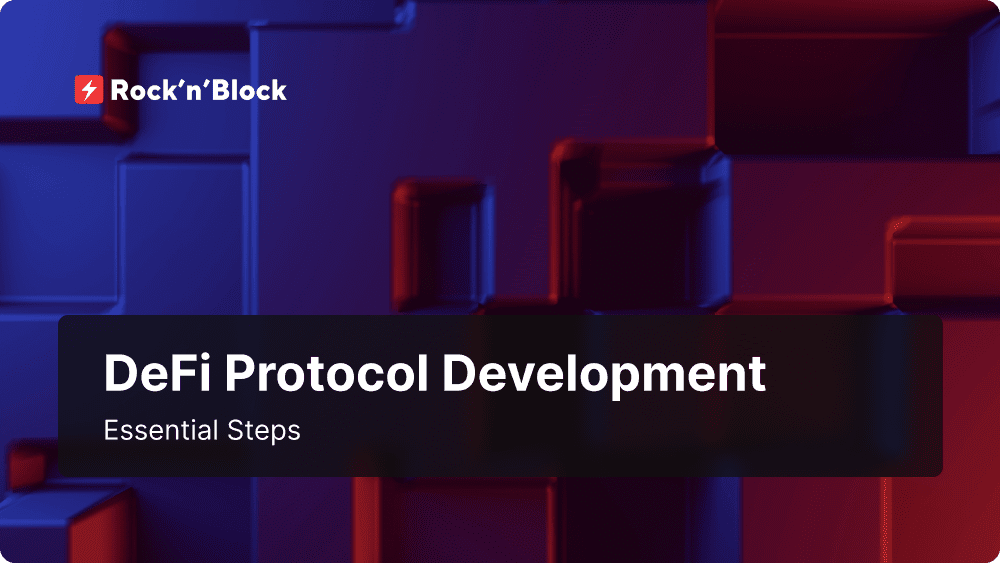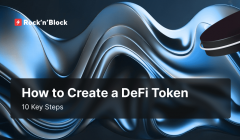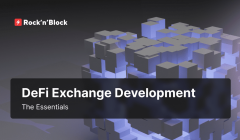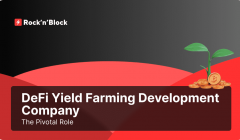DeFi Protocol Development Essential Steps
03 May 2024This article provides a detailed overview of DeFi protocol development. It covers core principles, challenges faced by developers, and innovative solutions that are paving the way for a more inclusive and decentralized financial ecosystem.
 Table of Contents:
Table of Contents:
-
Importance of DeFi Protocols in the Financial Ecosystem
-
Fundamentals of DeFi Protocols
-
Planning Your DeFi Protocol
-
Choosing the Right Blockchain
-
Smart Contract Development
-
Tokenomics and Governance
-
Integration with External Services
-
User Experience in DeFi Protocol Development
-
Testing and Deployment
-
Conclusion
Importance of DeFi Protocols in the Financial Ecosystem
The DeFi protocol development is revolutionizing finance by eliminating traditional intermediaries through blockchain technology and smart contracts, providing global and inclusive access to financial services. This decentralized approach increases security, transparency and efficiency, while fostering innovation through an open and permissionless environment. By enabling asset tokenization, yield farming development, and community governance, DeFi is transforming the financial ecosystem, giving users direct control, passive income opportunities, and a voice in the governance of these decentralized platforms.
Fundamentals of DeFi Protocols
DeFi development is reshaping traditional finance through protocols rooted in decentralization and token standards. This part explores the core principles of decentralization and the importance of token standards in fostering interoperability within the DeFi ecosystem.
Decentralization Essentials
DeFi protocols provide decentralization through:
1. Distributed Ledger Technology: Blockchain ensures transparency and tamper resistance by distributing transaction data across a network of nodes, eliminating the need for central validation.
2. Smart Contracts: Self-executing smart contracts development automates financial processes without intermediaries, enhancing trust and transparency in DeFi operations.
3. Governance: Decentralized governance empowers the community, allowing token holders to influence protocol decisions and ensuring a democratic evolution.
4. Open Source Development: Open-source development encourages collaboration and transparency, preventing the concentration of power.
Token Standards and Interoperability
Token standards, such as ERC-20 and ERC-721, facilitate interoperability:
1. ERC-20 Standard
Fungibility: Exchangeable tokens increase liquidity on decentralized exchanges and lending platforms.
Interoperability: Compliance with ERC-20 enables tokens to interact seamlessly with various DeFi applications, enhancing their usability.
2. ERC-721 Standard
Non-Fungibility: Uniqueness distinguishes ERC-721 tokens, making them ideal for representing ownership of digital or physical assets in NFT development.
Interoperability for Unique Assets: ERC-721 tokens allow unique digital assets like NFTs to be staked, lended and traded across different platforms.
To navigate the evolving landscape of decentralized finance, it is vital to understand the fundamentals of DeFi development, including decentralization principles and token standards. These fundamentals will remain pivotal in shaping a resilient and interoperable financial ecosystem as DeFi continues to redefine the future of finance.
Planning Your DeFi Protocol
A successful DeFi protocol development requires strategic planning to address market needs, define objectives, and ensure regulatory compliance. This section outlines key considerations for planning your DeFi project.
Market Insights: Identify issues in traditional finance that your protocol can solve. Analyze the DeFi landscape to discover areas where existing protocols fall short.
Protocol Objectives: Clearly define your protocol's primary purpose, whether it's lending, decentralized exchange development, or other financial services.
Research Regulations: Understand regulatory environments in operating jurisdictions to ensure compliance.
Choosing the Right Blockchain
Choosing the right blockchain is a critical step in the successful DeFi protocol development. This section explores key considerations, security and scalability assessments to aid in your decision-making process.
Overview of Blockchain Platforms for DeFi Development
Ethereum: Ethereum is well-known for hosting most of DeFi projects. It provides a strong ecosystem with smart contract capabilities using a solidity programming language.
BNB Chain: BNB Chain provides high throughput and lower transaction costs, making it another attractive option for DeFi developers.
Polygon: Designed to enhance Ethereum scalability, Polygon offers a layer 2 scaling solution, reducing transaction fees and latency.
Evaluating Security and Scalability
Evaluate the security measures employed by the blockchain, including consensus mechanisms, smart contract auditing, and the platform's overall track record.
Take into account blockchain's scalability features, such as transaction speed and throughput. A scalable blockchain is essential to handle an increasing number of users and transactions.
Reviewing successful case studies also provides valuable insights into the effectiveness of specific blockchains in supporting a successful DeFi platform development. As the DeFi landscape evolves, selecting the most suitable blockchain will become a strategic cornerstone for the project's success.
Smart Contract Development
Smart contract development is a cornerstone of DeFi protocols, influencing security, efficiency, and overall functionality. In this part, we explore the essentials of building secure contracts, the role of oracles, and the importance of rigorous testing and auditing.
Writing Secure and Efficient Smart Contracts
Security Best Practices: Follow industry best practices for secure smart contract development. This includes validating inputs, avoiding reentrancy vulnerabilities, and ensuring proper access control.
Gas Efficiency: Optimize smart contracts for gas efficiency to minimize transaction costs. Efficient use of storage, algorithm selection, and avoiding unnecessary computations are key considerations.
Use of Oracles in DeFi Protocols
Oracles serve as a connection between on-chain smart contracts and off-chain data sources, providing necessary external information to DeFi protocols.
It is important to choose oracles with a proven track record for accuracy and reliability to ensure the integrity of data inputs, which is critical for the proper functioning of DeFi applications.
To mitigate single points of failure, it is recommended to prioritize the decentralization of oracles. Additionally, utilizing multiple oracles and consensus mechanisms can enhance reliability in DeFi protocols development.
Testing and Auditing Smart Contracts
It is important to thoroughly test smart contracts under various conditions, including unit testing, integration testing, and stress testing, to identify and address potential vulnerabilities. A security audit in DeFi protocol development plays a crucial role, ensuring the integrity and resilience of the system against potential cyber threats and attacks.
Additionally, continuous monitoring mechanisms should be implemented to detect and respond to any post-deployment security threats.
Smart contract development is the backbone of DeFi protocols, shaping their security and functionality. By following best practices, optimizing for efficiency, integrating reliable oracles, and undergoing rigorous testing and auditing, DeFi development company can create robust and secure smart contracts. As the DeFi space continues to evolve, a meticulous approach to smart contract development remains paramount for project success.
Tokenomics and Governance
Tokenomics and governance shape the core of DeFi protocol development, influencing community engagement and project success. This part delves into the strategic tokenomics design for your protocol.
Designing a Token Economy
Utility and Scarcity: Define the utility of the token to make it a must-have, encouraging demand and scarcity.
Token Distribution: Distribute tokens strategically to reward early adopters and maintain community diversity.
Liquidity Mining and Staking: Implement mechanisms that encourage users to lock tokens, boosting network security and rewarding participation.
Governance Rights: Empower token holders to make decisions, promoting community ownership and decentralization.
Vesting Periods: Introduce a gradual release of tokens to align incentives and prevent market manipulation.
Fee Mechanisms: Incorporate fee structures that involve the usage of tokens to contribute to the sustainability of the protocol.
Adaptability: Plan for adjustments based on community feedback, market conditions, and protocol evolution.
A thoughtful tokenomics model is pivotal for successful DeFi protocol development. To create a token economy that aligns expectations, fosters community engagement and ensures sustainable growth, you need to consider utility, distribution, governance and adaptability. Innovative and strategic tokenomics will define project success.
Integration with External Services
Integration with external services is a crucial aspect of DeFi protocol development, enabling seamless functionality and expanding the reach of decentralized financial ecosystems.
Leveraging Decentralized Finance Infrastructure
Efficient DeFi protocols leverage existing decentralized finance infrastructure. This involves utilizing decentralized storage solutions, blockchain explorers, and other decentralized tools to improve the overall reliability and decentralization of the protocol.
Integrating with Wallets, Exchanges, and Liquidity Pools
DeFi protocols integrate with wallets, exchanges, and liquidity pools to improve user accessibility and liquidity. Connecting with widely used wallets, decentralized exchanges, and DeFi protocols ensure that users can easily interact with their assets within the broader DeFi ecosystem.
Cross-Protocol Collaboration and Interoperability
To ensure the growth and versatility of the DeFi space, it is essential to promote cross-protocol collaboration and interoperability. Protocols should aim to interact seamlessly with other DeFi projects, enabling users to move assets and data across different platforms. This interconnection fosters a more robust decentralized financial ecosystem.
Integrating external services is a strategic move in DeFi protocol development. Leveraging existing infrastructure, connecting with wallets and exchanges, and promoting interoperability contribute to a more user-friendly, accessible, and collaborative decentralized finance landscape.
User Experience in DeFi Protocol Development
User-friendly interfaces are crucial in DeFi protocol development. The complexity of financial processes requires intuitive designs that cater to users with varying levels of experience.
Prioritizing intuitive user experiences is key. Simplifying processes such as lending and trading ensures that users can interact seamlessly. Clear information display contributes to a positive user journey.
Ensuring accessibility is vital for widespread DeFi adoption. DeFi protocols should be designed to be inclusive and meet the diverse needs of users. Screen reader compatibility is an important feature that enhances overall accessibility.
To achieve this, it is fundamental to focus on user experience and interface design. User-friendly interfaces, intuitive experiences, and accessibility all contribute to the overall usability and inclusivity of decentralized financial platforms development.
Testing and Deployment
Testnet Deployment and Iterative Testing
Thorough testing on testnets is essential before deployment on the main network. Repeatable testing helps to identify and correct potential problems, ensuring the robustness of the protocol before it is released.
Mainnet Launch Strategies
It is crucial to plan the mainnet launch carefully. DeFi platform developers should consider launching in phases, starting with a limited audience before scaling up. This approach allows for real-world testing while minimizing potential risks.
Monitoring and Maintenance Post-Deployment
Continuous monitoring and post-deployment maintenance are vital. Proactive monitoring helps identify and address issues quickly, ensuring a smooth user experience. Ongoing maintenance guarantees the protocol's stability and security in the dynamic DeFi environment.
Conclusion
To ensure the success, security, and sustainability of any project, especially in the dynamic realm of DeFi, it is crucial to take each stage of the DeFi protocol development process with seriousness and care. A serious and thorough approach, from the conceptualization phase to deployment and ongoing maintenance, establishes a foundation of reliability and trust.
We ❤️ Development
Follow us on social media to receive the hottest blockchain development updates
Crunchbase ⚡️Twitter ⚡️Telegram⚡️LinkedIn⚡️Facebook⚡️Instagram⚡️Quora







